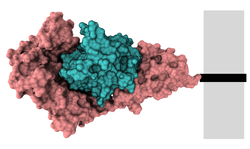Type 1 interleukin-1 receptor
| Type 1 interleukin-1 receptor | ||
|---|---|---|

|
||
| Surface model of the IL1R-IL1beta complex according to PDB 1ITB . The receptor protein continues into the membrane (scheme). | ||
| Properties of human protein | ||
| Mass / length primary structure | 552 amino acids | |
| Secondary to quaternary structure | single pass membrane receptor | |
| Identifier | ||
| Gene name | IL1R1 | |
| External IDs | ||
The interleukin-1 receptor type 1 (or short -1R1 ) is a cell membrane -ständiges receptor - protein . It is activated by interleukin-1α and interleukin-1β and, in contrast to interleukin-1 receptor type 2, carries their signals on. The interleukin-1 receptor type 1 acts on apoptosis , the MAP kinase pathway , and (as CD 121) is important for the regulation of certain aspects of hematopoiesis . It is coded on the chromosome segment 2q12 and has 569 amino acids. It is present on all cells and its expression is only slightly regulated. Rather, the activity of IL1R1 is regulated by equilibrium with an interleukin-1 receptor antagonist (IL1Ra) that is also formed by the organism . This can be produced recombinantly and is marketed as anakinra (Kineret ® ).
credentials
- ↑ See Pathways on the Kyoto Encyclopedia of Genes and Genomes (KEGG) .
- ↑ See Pathways on the Kyoto Encyclopedia of Genes and Genomes (KEGG) .
- ↑ See Pathways on the Kyoto Encyclopedia of Genes and Genomes (KEGG) .
- ↑ Dinarello, CA (2005): Blocking IL-1 in systemic inflammation . J Exp Med 201: 1355-9.